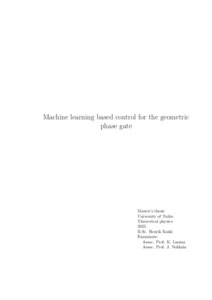Machine learning based control for the geometric phase gate
Koski, Henrik (2025-10-24)
Machine learning based control for the geometric phase gate
Koski, Henrik
(24.10.2025)
Julkaisu on tekijänoikeussäännösten alainen. Teosta voi lukea ja tulostaa henkilökohtaista käyttöä varten. Käyttö kaupallisiin tarkoituksiin on kielletty.
avoin
Julkaisun pysyvä osoite on:
https://urn.fi/URN:NBN:fi-fe20251029104003
https://urn.fi/URN:NBN:fi-fe20251029104003
Tiivistelmä
In this work the application of machine learning methods for quantum control of trapped ion quantum computers is studied. This is done in the framework of a single quantum gate, the geometric phase gate.
The fundamentals of trapping ions as well as machine learning are presented. The Hamiltoninan operator is derived for a system of two ions in a linear Paul trap. After presenting the consepts of open quantum systems and quantum computing in general, a master equation for two ions in a noisy environment that are driven by a laser is presented.
The solution to the master equation is used to generate datasets that corresond to the application of a geometric phase gate. The datasets are then used to train a variety of machine learning models that emulate the mapping from the shape of the control laser all the way to the resulting fidelity of the gate operation. The output of the models is then optimised to acquire the optimal control parameters describing the laser pulse.
The fundamentals of trapping ions as well as machine learning are presented. The Hamiltoninan operator is derived for a system of two ions in a linear Paul trap. After presenting the consepts of open quantum systems and quantum computing in general, a master equation for two ions in a noisy environment that are driven by a laser is presented.
The solution to the master equation is used to generate datasets that corresond to the application of a geometric phase gate. The datasets are then used to train a variety of machine learning models that emulate the mapping from the shape of the control laser all the way to the resulting fidelity of the gate operation. The output of the models is then optimised to acquire the optimal control parameters describing the laser pulse.
